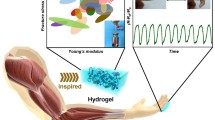Abstract
A procedure was developed for preparing hybrid hydrogel specimens of preset configuration from cross-linked polyacrylic acid and polyvinyl alcohol. The specimens exhibit higher mechanical characteristics compared to hydrogels of cross-linked polyacrylic acid. Hydrogel specimens fabricated in the form of elastic rings demonstrate an electromechanical response, contraction on passing electric current through their cross section. This effect is more pronounced for the specimens swollen in a sodium sulfate solution than for those swollen in distilled water. The results obtained show that the hydrogels can be used as a linearly operating mechanical force generator (artificial muscle).
Similar content being viewed by others
References
Bar-Cohen, Y., Electroactive Polymer (EAP) Actuators as Artifi cial Muscles: Reality, Potential, and Challenges, Bellingham SPIE, 2004.
Osada, Y. and Gong, J., Prog. Polym. Sci., 1993, vol. 18, pp. 187–226.
Shiga, T., Adv. Polym. Sci., 1997, vol. 134, pp. 131–163.
Elyashevich, G.K., Smirnov, M.A., Bobrova, N.V., et al., Smart Nanocompos., 2012, vol. 3, no. 2, pp. 123–136.
Otake, M., Kagami, Y., Inaba, M., and Inoue, H., Robot. Autonom. Syst., 2002, vol. 40, pp. 185–191.
Budtova, T., Suleimenov, I., and Frenkel, S., Polym. Gels Networks, 1995, vol. 3, no. 3, pp. 387–393.
Rasmussen, L., Erickson, C.J., Meixler, L., et al., Polym. Int., 2010, vol. 59, pp. 290–299.
Byun, H., Hong, B., Nam, S.Y., et al., Macromol. Res., 2008, vol. 16, no. 3, pp. 189–193.
Bel’nikevich, N.G., Bobrova, N.V., Elokhovskii, V.Yu., et al., Russ. J. Appl. Chem., 2011, vol. 84, no. 12, pp. 2106-2113.
Author information
Authors and Affiliations
Corresponding author
Additional information
Original Russian Text © I.Yu. Dmitriev, V.P. Ivanov, N.V. Bobrova, Z.F. Zoolshoev, I.S. Kuryndin, G.K. Elyashevich, 2016, published in Zhurnal Prikladnoi Khimii, 2016, Vol. 89, No. 11, pp. 1472−1480.
Rights and permissions
About this article
Cite this article
Dmitriev, I.Y., Ivanov, V.P., Bobrova, N.V. et al. Hybrid hydrogels based on cross-linked polyacrylic acid and polyvinyl alcohol as electrically controlled artificial muscles. Russ J Appl Chem 89, 1838–1845 (2016). https://doi.org/10.1134/S107042721611015X
Received:
Published:
Issue Date:
DOI: https://doi.org/10.1134/S107042721611015X




